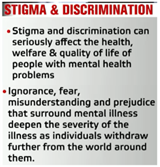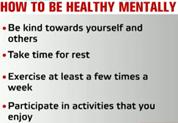

Introduction:
- 10th of October every year is observed as World Mental Health Day. The purpose is to spread awareness about mental health issues around the world and mobilize efforts in support of mental health. Mental health is an integral and essential component of health. It is fundamental to our collective and individual ability as humans to think, emote, interact with each other, earn a living and at the same time, enjoy life. The level of mental health of a person is determined by multiple social, psychological, and biological factors.
- This year, the theme of World Mental Health Day was "Suicide Prevention”. As per WHO data, every 40 seconds, someone loses their life to suicide. In fact, suicide is the principal cause of death among people in the age group of 15 to 29. In India, close to 14 percent of India’s population required active mental health interventions, as per the 2016 National Mental Health Survey.
Edited excerpts from the debate:
Question: What is mental health?
- The World Health Organization defines mental health as “a state of well-being in which every individual realizes his or her own potential, can cope with the normal stresses of life, can work productively and fruitfully, and is able to make a contribution to her or his community”.
- The absence of mental disorder does not necessarily mean the presence of good mental health. People living with mental disorder can also achieve good levels of wellbeing – living a satisfying, meaningful, contributing life within the constraints of painful, distressing, or debilitating symptoms.
Question: What are the reasons for increasing cases of mental health?
- Changing lifestyle patterns: In last two decades there have been so many changes in lifestyle. There have been advances in information technology; the global virtual mobility has become much easier. In this period there has been more virtual communication and person to person communication has been going down which leads towards the mental illness.
- Social stigma and discrimination: People do not accept the fact that that they are suffering from mental illness. This mindset helps aggravate the health issues related to mental distress.

- Career driven mindset of parents: Parents see unfulfilled dreams of them into the eyes of their children. Hence they push children to achieve the desired goals of them without taking in to the consideration the will of their children. This leads to the mental health issues in many students. This could be the one of the reason for India having the highest number of suicides among youth.
- Extensive use of smartphones: Extensive use of mobile phones affects the sleep pattern of person which indirectly leads to the mental stress. Younger generation is mostly the victim of this.
- Demographic Determinants: Gender inequality, racial, regional and ethnic discrimination etc could lead to the mental health problems.
- Environmental Determinants: Natural hazards, industrial disasters, armed conflict, displacement, and disasters triggered by ecosystem hazards due to climate change or increased population results into the mental health problems.

Question: What are the different types of mental disorders?
In India WHO says that 7.5% of Indian population suffers from some form of mental disorder. Some of the mental disorders are explained below:
- Depression: Depression is characterized by sadness, loss of interest or pleasure, feelings of guilt or low self-worth, disturbed sleep or appetite, tiredness, and poor concentration. People with depression may also have multiple physical complaints with no apparent physical cause. Depression can be long-lasting or recurrent, substantially impairing people’s ability to function at work or school and to cope with daily life. At its most severe, depression can lead to suicide.
- Bipolar affective disorder: This disorder affects about 60 million people worldwide. It typically consists of both manic and depressive episodes separated by periods of normal mood. Manic episodes involve elevated or irritable mood, over-activity, pressure of speech, inflated self-esteem and a decreased need for sleep. People who have manic attacks but do not experience depressive episodes are also classified as having bipolar disorder.
- Schizophrenia and other psychoses: Schizophrenia is a severe mental disorder, affecting about 23 million people worldwide. Psychoses, including schizophrenia, are characterized by distortions in thinking, perception, emotions, language, sense of self and behaviour.
- Dementia: Worldwide, approximately 50 million people have dementia. Dementia is usually of a chronic or progressive nature in which there is deterioration in cognitive function (i.e. the ability to process thought) beyond what might be expected from normal ageing. It affects memory, thinking, orientation, comprehension, calculation, learning capacity, language, and judgement.
Question: What should be done to tackle the increasing menace of mental health?
Individual awareness:
Individual should take care of own mental health instead of depending on others.
- Relaxation exercises and prayer can improve the state of mind and outlook on life. In fact, research shows that meditation may help you feel calm and enhance the effects of therapy.

- Taking care of self physically can improve one’s mental health.
Eating nutritious meals, avoiding cigarettes, drinking plenty of water will help decrease depression and anxiety and improve moods.

- Individuals themselves should Keep alcohol use to a minimum and avoid other drugs. Sometimes people use alcohol and other drugs to "self-medicate" but in reality, alcohol and other drugs only aggravate problems.
- Policies to reduce alcohol and drug consumption: There should be a comprehensive policy which focuses on measures to reduce the consumption of alcohol.
- By providing affordable as well as easily accessible services like psychiatry by governments and providing basic health care facilities at the door step.
- There should be proper training of persons who treat and handle the patients and take care of mental health patients. e.g. How to interact and communicate with mentally ill patients etc.

- Reducing treatment gap: There is need to enhance the availability and distribution of skilled human resources for mental health to reduce the treatment gap.
- Actions to support mental health among children and adolescents:
- Schools play an integral role in nurturing development in terms of social, emotional, academic, and cognitive ability; the effects of which can influence children’s short- and long-term mental health.
- Make mental health a part of school curriculum.
- To support mental health among older: Promoting interventions which prolong and/or improve older people’s social activities, life satisfaction, and quality of life can significantly reduce depressive symptoms and protect against risk factors, such as social isolation.
Question: What are the initiates taken by the government to tackle mental health problem?
- National Mental Health Programme: The Government of India launched the National Mental Health Programme (NMHP) in 1982, keeping in view the heavy burden of mental illness in the community, and the absolute inadequacy of mental health care infrastructure in the country to deal with it. Three main components of NMHP are:
- Treatment of Mentally ill
- Rehabilitation
- Prevention and promotion of positive mental health.
- District Mental Health Program: It envisages provision of basic mental health care services at the community level. Its objectives are:
- To provide sustainable basic mental health services to the community and to integrate these services with other health services.
- Early detection and treatment of patients within the community itself
- To reduce the stigma of mental illness through public awareness.
- To treat and rehabilitate mental patients within the community.
- The Mental Health Care Act 2017: It is an act to provide for mental healthcare and services for persons with mental illness and to protect, promote and fulfil the rights of such persons during delivery of mental healthcare and services and for matters connected therewith or incidental thereto.
- The National Institute of Mental Health (NIMH): It is the lead federal agency for research on mental disorders. NIMH is one of the 27 Institutes and Centres that make up the National Institutes of Health (NIH), the largest biomedical research agency in the world.
Conclusion:
The biggest problem today is that the discovery of mental illness is often followed by denial and hesitations to seek help. Despite its enormous social burden, mental health today remains a taboo, stigma, prejudice and fears. So there is a need to educate people about the reality that the mental illness is more common than the people realises. It is the society’s responsibility to make people aware of the mental illness and get people more talking about it.
Question: What are the reasons for the increasing mental health cases in India? Discuss the ways to tackle impacts of mental disorders.
More Articles


